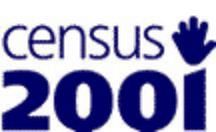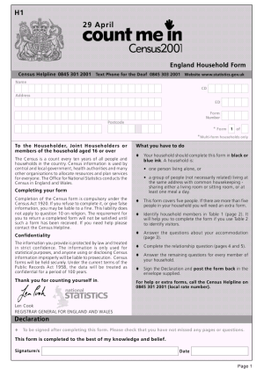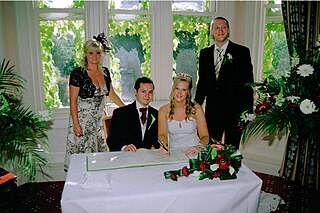The Office for National Statistics is the executive office of the UK Statistics Authority, a non-ministerial department which reports directly to the UK Parliament.
Civil partnership in the United Kingdom is a form of civil union between couples open to both same-sex couples and opposite-sex couples. It was introduced via the Civil Partnership Act 2004 by the Labour government. The Act initially permitted only same-sex couples to form civil partnerships, but the law was expanded to include opposite-sex couples in 2019.

A nationwide census, known as Census 2001, was conducted in the United Kingdom on Sunday, 29 April 2001. This was the 20th UK census and recorded a resident population of 58,789,194.
Vital statistics is accumulated data gathered on live births, deaths, migration, fetal deaths, marriages and divorces. The most common way of collecting information on these events is through civil registration, an administrative system used by governments to record vital events which occur in their populations. Efforts to improve the quality of vital statistics will therefore be closely related to the development of civil registration systems in countries. Civil registration followed the practice of churches keeping such records since the 19th century.

The General Register Office for England and Wales (GRO) is the section of the United Kingdom HM Passport Office responsible for the civil registration of births, adoptions, marriages, civil partnerships and deaths in England and Wales and for those same events outside the UK if they involve a UK citizen and qualify to be registered in various miscellaneous registers. With a small number of historic exceptions involving military personnel, it does not deal with records of such events occurring within the land or territorial waters of Scotland, Northern Ireland or the Republic of Ireland; those entities' registration systems have always been separate from England and Wales.
The United Kingdom Census 1901 was the 11th nationwide census conducted in the United Kingdom of Great Britain and Ireland, and was done on 31 March 1901 "relating to the persons returned as living at midnight on Sunday, March 31st".
Civil registration is the system by which a government records the vital events of its citizens and residents. The resulting repository or database has different names in different countries and even in different subnational jurisdictions. It can be called a civil registry, civil register, vital records, and other terms, and the office responsible for receiving the registrations can be called a bureau of vital statistics, registry of vital records and statistics, registrar, registry, register, registry office, or population registry. The primary purpose of civil registration is to create a legal document that can be used to establish and protect the rights of individuals. A secondary purpose is to create a data source for the compilation of vital statistics.

The General Register Office for Scotland (GROS) was a non-ministerial directorate of the Scottish Government that administered the registration of births, deaths, marriages, divorces and adoptions in Scotland from 1854 to 2011. It was also responsible for the statutes relating to the formalities of marriage and conduct of civil marriage in Scotland. It administered the census of Scotland's population every ten years. It also kept the Scottish National Health Service Central Register.
His Majesty's Land Registry is a non-ministerial department of His Majesty's Government, created in 1862 to register the ownership of land and property in England and Wales. It reports to the Ministry of Housing, Communities, and Local Government. The registry contains 87% of land in England and Wales as of 2019.

Coincident full censuses have taken place in the different jurisdictions of the United Kingdom every ten years since 1801, with the exceptions of 1941, Ireland in 1921/Northern Ireland in 1931, and Scotland in 2021. In addition to providing detailed information about national demographics, the results of the census play an important part in the calculation of resource allocation to regional and local service providers by the UK government.

General Register Office or General Registry Office (GRO) is the name given to the civil registry in the United Kingdom, many other Commonwealth nations and Ireland. The GRO is the government agency responsible for the recording of vital records such as births, deaths, and marriages, which may also include adoptions, stillbirths, civil unions, etc., and historically, sometimes included records relating to deeds and other property transactions.
Land registration is any of various systems by which matters concerning ownership, possession, or other rights in land are formally recorded to provide evidence of title, facilitate transactions, and prevent unlawful disposal. The information recorded and the protection provided by land registration varies widely by jurisdiction.

The Census Act 1800 – also known as the Population Act 1800 – was an Act of the Parliament of Great Britain which enabled the first Census of England, Scotland and Wales to be undertaken. The census was carried out in 1801 and has been repeated almost every ten years thereafter. The 1801 census estimated the population of England and Wales to be 8.9 million, and that of Scotland was 1.6 million. Ireland was not included in the census until 1821.
The United Kingdom Census of 1851 recorded the people residing in every household on the night of Sunday 30 March 1851, and was the second of the UK censuses to include details of household members. However, this census added considerably to the fields recorded in the earlier 1841 UK Census, providing additional details of ages, relationships and origins, making the 1851 census a rich source of information for both demographers and genealogists.

The Census Act 1920 is an Act of the Parliament of the United Kingdom. Providing for a census for Great Britain, on a date to be fixed by Order in Council, it remains the primary legislation for the provision of the UK census in England, Scotland, and Wales. A minimum of five years is required between censuses.

The National Registration Act 1939 was an Act of Parliament in the United Kingdom. The initial National Registration Bill was introduced to Parliament as an emergency measure at the start of the Second World War.
Beyond 2011, also known as The Beyond 2011 Programme, was a project initiated by the UK Statistics Authority to look at the alternatives to running a UK census in 2021. In 2008, the Treasury Select Committee had expressed concerns about the increasing cost of running the census and inaccuracies in data gathered only every ten years. In 2010 the newly elected coalition government reiterated such concerns responding to a report by the UK Statistics Authority.

A civil, or registrar, ceremony is a non-religious legal marriage ceremony performed by a government official or functionary. In the United Kingdom, this person is typically called a registrar. In the United States, civil ceremonies may be performed by town, city, or county clerks, judges or justices of the peace, or others possessing the legal authority to support the marriage as the wedding officiant.

The 1841 Census of Ireland was a census that covered the whole island of Ireland. It was conducted as part of the broader 1841 United Kingdom census, which was the first modern census undertaken in the UK. The census is of particular note in Ireland as it was taken shortly before the Great Famine (1845-1852), which resulted in over 1 million deaths and spurred decades of mass emigration. The total population of the island in 1841 was estimated to be just under 8.2 million, which remains the highest recorded population Ireland has ever had. During this year, Ireland also held about 31% of the UK's population. As of the latest censuses – 2022 in the Republic of Ireland and 2021 in Northern Ireland – the island's population stood at just over 7 million, roughly 16% lower than its pre-famine peak.








